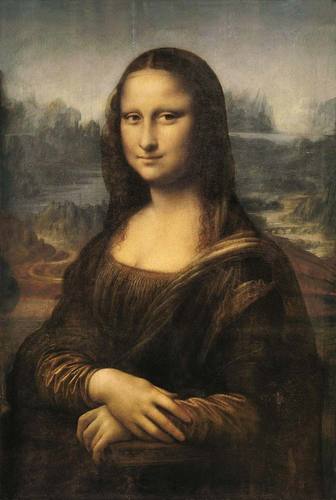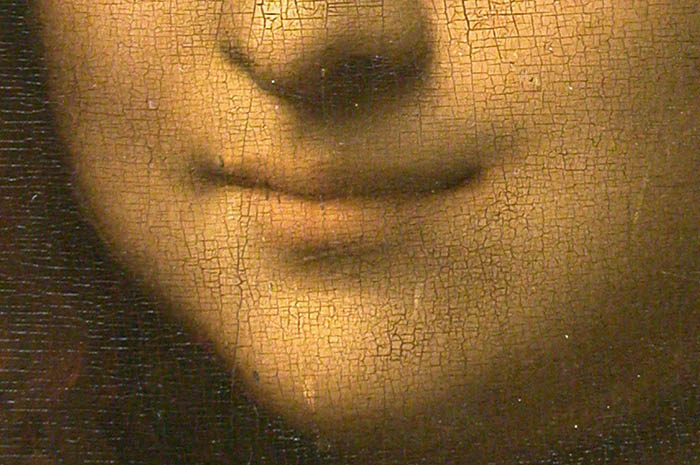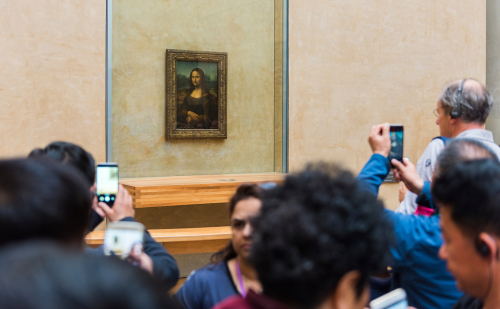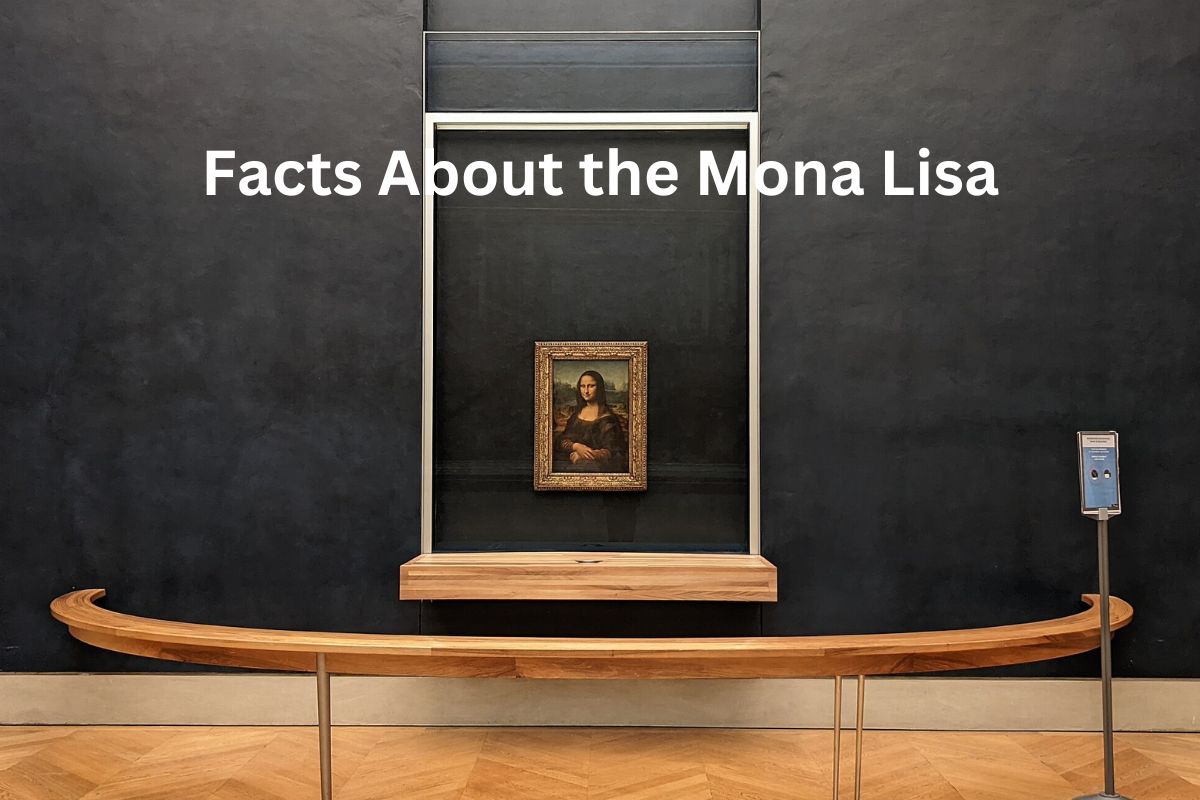The Mona Lisa is one of the most famous paintings in the world, and it has captivated viewers for centuries with its enigmatic smile and serene beauty.
Painted by Leonardo da Vinci during the Renaissance period, the Mona Lisa has become an iconic symbol of art and culture, and its history is rich with fascinating stories and mysteries.
In this list of facts, I’ll share some interesting tidbits about the painting’s creation, its journey through history, and its enduring legacy.
Mona Lisa Facts
1. The painting is also known as La Gioconda
The Mona Lisa is sometimes referred to as La Gioconda, which is the Italian version of Lisa Gherardini’s married name, Giocondo.
The title may also have been inspired by the sitter’s smile, which is often described as “enigmatic” or “mysterious,” similar to the meaning of the word “gioconda” in Italian.

Today, both names are used interchangeably to refer to the painting, and they have become almost as famous as the artwork itself.
2. Leonardo da Vinci painted the Mona Lisa between 1503 and 1506
Leonardo da Vinci started working on the Mona Lisa in 1503, and it took him around three years to complete the painting. He painted it during the Renaissance period, which was a time of great artistic and intellectual flourishing in Europe.

The Mona Lisa is considered one of da Vinci’s masterpieces, and it’s widely regarded as one of the greatest works of art ever created. Its enduring popularity and influence continue to inspire artists and viewers alike more than five centuries later.
3. The painting is believed to have been commissioned by Francesco del Giocondo
It’s widely believed that the Mona Lisa was commissioned by Francesco del Giocondo, a wealthy Florentine silk merchant, and Lisa Gherardini’s husband.
According to some art historians, the painting was intended as a portrait of Lisa Gherardini to celebrate her pregnancy or the birth of her second son.
Others believe that it was simply a portrait that da Vinci painted of a well-to-do Florentine woman.
Regardless of its original purpose, the Mona Lisa has become one of the most iconic and mysterious paintings in history, and it continues to inspire fascination and speculation among art lovers and scholars alike.
4. The Mona Lisa is painted on a poplar wood panel
The Mona Lisa is painted on a poplar wood panel, which was a common surface for painting during the Renaissance period.
The panel measures approximately 77 cm by 53 cm (30 inches by 21 inches), and it’s made up of several pieces of wood that have been joined together. The wood panel provides a stable and durable surface for the painting, and it has helped to preserve the artwork for centuries.
The use of a wood panel also allowed da Vinci to create the fine details and subtle tonal variations that are characteristic of the painting, and it helped him to achieve the smooth, enigmatic quality of the Mona Lisa’s skin and clothing.
5. The painting is relatively small
The Mona Lisa is relatively small, measuring just 30 inches (77 cm) by 21 inches (53 cm). This size was fairly typical for portrait paintings during the Renaissance period, when the emphasis was on capturing the likeness and character of the sitter rather than creating a grand or imposing composition.
Despite its small size, however, the Mona Lisa has had a huge impact on the world of art and culture, and it remains one of the most widely recognized and admired paintings in history.
Its intimate scale also adds to the enigmatic and captivating quality of the painting, drawing viewers in to examine its details and mysteries up close.
6. The Mona Lisa is known for her enigmatic smile
The Mona Lisa is known for her enigmatic smile, which has fascinated and puzzled viewers for centuries.
The smile is often described as subtle, mysterious, and almost imperceptible, and it has been the subject of countless interpretations and analyses by art historians, psychologists, and scientists.

Some theories suggest that the smile is a symbol of feminine mystique or eroticism, while others suggest that it’s a sign of inner peace or contentment.
Still, others propose that it’s simply a product of da Vinci’s mastery of painting and his ability to create lifelike expressions and emotions.
Whatever the interpretation, the Mona Lisa’s smile remains one of the most iconic and enduring mysteries of the art world, and it continues to inspire fascination and speculation among viewers and scholars alike.
7. The painting was stolen from the Louvre in 1911
The Mona Lisa was stolen from the Louvre in Paris in 1911, where it had been on display since 1797. The thief, a former Louvre employee named Vincenzo Peruggia, simply walked into the museum, removed the painting from its frame, and walked out with it hidden under his coat.
The theft caused a sensation around the world, and the Mona Lisa was missing for two years before it was finally recovered in Florence, Italy in 1913. Peruggia had tried to sell the painting to a local art dealer, but he was eventually caught and arrested.
The theft and recovery of the Mona Lisa only added to the painting’s fame and mystique, and it remains one of the most famous art heists in history.
8. The Mona Lisa was once owned by King Francis I of France
After the Mona Lisa was completed by Leonardo da Vinci, it was acquired by King Francis I of France, who was a great admirer of Italian art and culture. Francis I displayed the painting in his palace at Fontainebleau, where it remained for several years.
Later, the painting was moved to the Palace of Versailles, where it was displayed alongside other great works of art from the royal collection.
Today, the Mona Lisa is part of the permanent collection at the Louvre Museum in Paris, where it has been on display since 1797. Its fame and importance have only increased over time, making it one of the most beloved and celebrated paintings in the world.
9. The painting has been damaged several times over the years
The Mona Lisa has been damaged several times over the years, including an incident in 1956 when a man named Ugo Ungaza Villegas threw acid at the painting, damaging the lower part of the painting and the sitter’s left elbow.
The attack caused shock and outrage around the world, and experts worked tirelessly to restore the painting to its original condition.

Other incidents of damage include cracks in the paint caused by fluctuations in temperature and humidity, as well as wear and tear caused by years of handling and display.
Today, the Mona Lisa is protected behind a thick layer of bulletproof glass, which helps to safeguard it from any future damage or attempts at theft.
10. The Mona Lisa has been exhibited in several countries
The Mona Lisa has been exhibited in several countries around the world, including the United States, Japan, and Russia, among others. Its international tours have drawn huge crowds and media attention, and they have helped to cement the painting’s status as one of the most iconic and beloved works of art in history.
Some of the most notable exhibitions of the Mona Lisa include its visit to the Metropolitan Museum of Art in New York in 1963, where it attracted more than a million visitors, and its visit to Tokyo’s National Museum of Western Art in 1974, which was the first time the painting had ever been displayed in Japan.
These international exhibitions have provided viewers around the world with the opportunity to see the painting up close and to appreciate its subtle beauty and enduring mysteries.
11. It is valued at an estimated $800 million
The Mona Lisa is considered one of the most valuable artworks in the world, and it’s estimated to be worth around $800 million. This valuation takes into account various factors, such as the painting’s historical significance, its rarity, and its cultural importance.
The painting is also insured for an enormous sum, which reflects its immense value and the measures that are taken to protect it from damage or theft.
Despite its incredible value, the Mona Lisa remains on public display at the Louvre in Paris, where it can be viewed and enjoyed by millions of people from around the world.
12. The Mona Lisa is part of the permanent collection at the Louvre in Paris
The Mona Lisa has been part of the permanent collection at the Louvre Museum in Paris since 1797, where it is displayed alongside thousands of other great works of art from around the world.
The painting is housed in a specially designed climate-controlled enclosure, which protects it from fluctuations in temperature, humidity, and light.
Despite the painting’s immense popularity and value, it remains one of the most accessible works of art in the world, as visitors to the Louvre can view it in person as part of their admission to the museum.
The painting is a major draw for tourists and art lovers from around the world, and it continues to inspire awe and wonder in viewers of all ages.
13. The Mona Lisa has been the subject of countless imitations and parodies
The Mona Lisa has inspired countless imitations and parodies over the years, as artists and creators from a wide range of fields have sought to pay tribute to the painting or to put their own spin on its iconic image.
Some of the most notable examples of Mona Lisa imitations and parodies include Salvador Dali’s “Mona Lisa with Moustache,” which features a surrealistic version of the painting with a moustache added to the sitter’s face, and Andy Warhol’s series of silkscreen prints that incorporate the Mona Lisa into his distinctive pop art style.
Other artists and creators have created their own variations on the painting, such as the popular internet meme “Monalisa with a Smirk,” which features the Mona Lisa with a mischievous grin added to her enigmatic smile.
These imitations and parodies have helped to keep the Mona Lisa relevant and fresh in popular culture, while also demonstrating the enduring appeal and impact of the painting itself.
14. The painting has inspired numerous works of literature, music, and film
The Mona Lisa has inspired numerous works of literature, music, and film over the years, as artists and creators have sought to capture the painting’s beauty, mystery, and cultural significance.
One of the most famous examples is Dan Brown’s novel “The Da Vinci Code,” which uses the Mona Lisa as a key plot point and explores its connection to various conspiracies and secrets throughout history.
The novel was a bestseller around the world and has been adapted into a major motion picture and a popular video game, cementing the Mona Lisa’s status as a cultural touchstone and symbol of intrigue and mystery.
Other works that have been inspired by the Mona Lisa include poems, songs, plays, and films, all of which have sought to capture the painting’s enduring appeal and fascination.
15. The Mona Lisa has been analyzed extensively by art historians and scientists
The Mona Lisa has been the subject of extensive analysis and research by art historians and scientists, who have studied everything from the pigments used in the painting to the identity of the woman who posed for it.
The painting has been examined using a wide range of scientific techniques, including x-ray and infrared imaging, which have revealed hidden details and insights into da Vinci’s creative process.
Art historians have also conducted in-depth research into the painting’s historical and cultural context, seeking to understand the reasons for its enduring popularity and fascination. One of the biggest mysteries surrounding the painting is the identity of the woman who posed for it, which remains a subject of debate and speculation among experts.
Despite the intense scrutiny that the painting has received over the years, however, its enigmatic smile and subtle beauty continue to captivate and inspire viewers around the world, making it one of the most enduring and beloved works of art in history.

